The TREMOREX [TX] project produced unprecedented movement disorder improvements exemplified by six participants described herein.
GENERAL
Whereas their experiences varied in some respects, they all experienced nearly complete tremor mitigation for protracted periods following their first TX session and systemic restoration of other movement disorder symptoms that participants and other witnesses described.
Note: tremors are a symptom and a biomarker of movement disorders. It is the easiest symptom to observe, measure, and quantitively track real-time and long-term improvement. Quantitative tremor measurements can be taken anytime and take seconds rather than qualitative assessments of other symptoms performed in a doctor’s office using a variety of lengthy procedures.at
As tremors are mitigated, other symptoms are mitigated
First TX session results:
The first TX session showed an average 96% improvement in tremor that lasted 17 hours among 7 subjects including 5 of the 6 participants described in this report. Other subjects had similar experiences but could only provide estimates as no measurement device was available at the time.
Successive TX session results:
Sessions were scheduled once per day with durations of from 4 to 12 minutes. Tremor measurements were taken BEFORE and AFTER each TX session. BEFORE measurements diminished with each session and became essentially equal to AFTER measurements indicating the TX Duration of Improvement [DOI], exceeding 1 day. The time between TX sessions [gaps] was progressively increased as DOI continued to increase.
DOI increased from days to months to possibly perpetual
The effect of TX is cumulative
As DOI increased, scheduling gave way to events like: improvement starting to decay typically because of unusually large gaps between sessions or when episodic tremors caused by unusually high stress occur.
Participants discovered they could stop episodic tremors mentally
NOTE: This never before TX experience indicates that TX has raised the threshold wherein the level of stress required to trigger an episode has increased and the effort to stop tremor has decreased. We are moving in a direction wherein episodes may cease altogether.
Project considerations
TX sessions were conducted whilst subjects were being treated with prescribed medications. All attempts to discuss cooperative relationships with treating entities, typically neurologists, failed. The intent was to adjust drug treatment in concert with subject improvement. To determine the % improvement and DOI attributable to TX, sessions were performed prior to medication when symptoms would be at their maximum. Nevertheless, and surprisingly, TX performance did not appear to be affected by the medications or our scheduling strategy. The results were the same.
TX works despite hostile environments
Baseline tremor
Tremor was measured prior to commencement of TX sessions to establish a pre-TX baseline against which TX performance could be measured.
INDIVIDUAL SUBJECT IMPROVEMENT
BEN IMPROVEMENT
Ben is diagnosed with Essential Tremor. We established a baseline with 9 measurements taken over a 4-Month period commencing October 2016. Baseline average = 2.61.
In 2017, 441 measurements were taken, including Before and After sessions. The average tremor amplitude = .0242 for an improvement of 99.07%.
2017 Improve
Baseline AVG 2.61
TX AVG .0242
Improve % 99.07

Ben 2017 Tremor Amplitude
Arrow 1. Baseline 2.61.
Arrow 2. Ben went to gym and immediately after his workout took a Before TX measurement of 1.44. 15 minutes after TX, he measured .42. He continued to take measurements and they essentially ceased within a few hours.
Arrows 3 and 4. The cause of these episodes are unknown and probably due to extreme fatigue or stress. They are Before TX measurements that subsided immediately following a TX session.
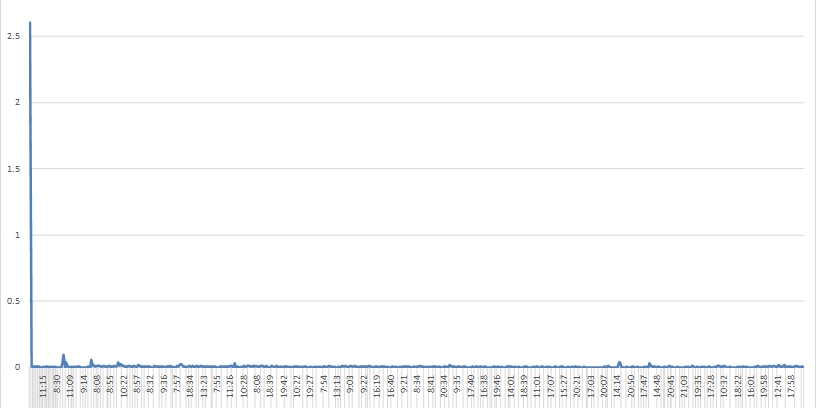
Ben 2018 Tremor Amplitude
In 2018, 580 measurements were taken, including Before and After sessions. The average tremor amplitude = .00417 for an improvement of 99.84%.
2018 Improve
Baseline AVG 2.61
TX AVG .004167
Improve % 99.84
No single measurement exceeded .098 or an improvement less than 96.24%
Today, Ben reports:
1. My tremor has decreased to an ongoing low level with occasional, short duration, stress induced higher levels.
2. I can usually stop the sporadic tremor by deciding to.
3. I haven’t used TREMOREX for many months and I stopped taking measurements as I know what they will be.
BILL IMPROVEMENT
Bill is diagnosed with Parkinson’s Disease. He has hand and leg tremor, and, suffers from Restless Leg Syndrome.
First time
Before 1.0067
After .0125
Tx duration 6 Min
Improvement duration 18 hours to 50% reduction
First time Improvement 98.8%
Long term Improvement 83.65% to 98.95% plus
In 2017, 73 measurements were taken, including Before and After sessions over a 13-month period. The average tremor amplitude = .0242 for an improvement of 99.07%.
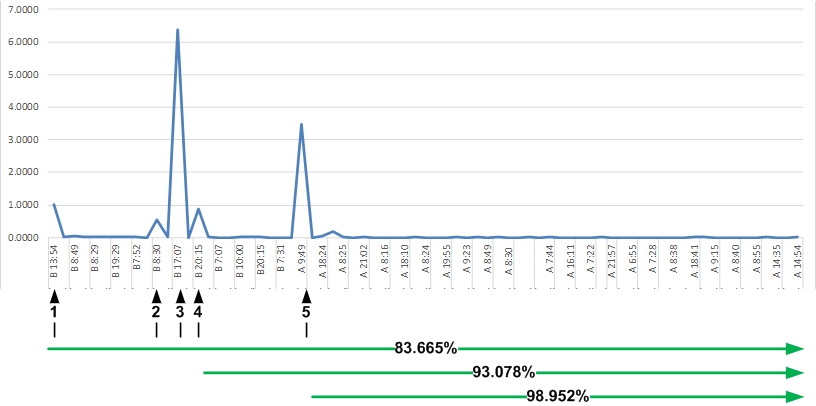
Bill Tremor Amplitude
Arrow 1. Baseline
Arrow 2. Higher than prior average tremor is mitigated by TX session.
Arrow 3. 8 hours after arrow 2, tremor is high and mitigated by a second TX session.
Bill sleeps well this evening.
Arrow 4. 3 days later, Bill experiences another episode. TX mitigates it and a new
normal is established for the next 7 weeks and continuing to date.
Arrow 5. This is an episode tremor that was mitigated with a single 5-min TX session.
The graph shows immediate results following the first TX session and tremor episodes over the first 8 days: from arrow 1 to arrow 5. After this 8-day period, and beyond the graph for 3 years, Bill reported occasional episode tremors mitigated by mental control or a single 4-min TX session. If you consider the episodes as part of the learning curve and measure the improvement following it, improvement increases from 83.665% to 98.95% as indicated by the green arrows.
Today, Bill reports:
1. “I have no more severe tremors like those in the videos”.
2. “Tremors are not active overall. Only have them periodically and minimally”.
3. “When I do get tremors, I am able to mentally stop them most of the time”.
4. “No tremor in his leg; none whatsoever”
5. “No more Restless Leg Syndrome”
6. “I’m happy the way I am”.
SAM IMPROVEMENT
Sam has Parkinson’s Disease and uses TX to mitigate the prominent tremor in his legs. Sam experienced improvements in other movement disorders following TX sessions. His gait, rigidity, handwriting and energy level improved even though his focus was on his leg tremors.
Over a 14-month period Sam did 17 TX sessions which are described in 3 distinct periods.
PERIOD 1 from 3/18/17 to 4/2/17 [16 days], during which 7 TX sessions were performed with an average gap between sessions of 2.28 days and an average improvement of 94.55% for both legs is set apart for analysis because it was discovered that a change in posture increased tremors and was adopted for use in periods 2 and 3.
Baseline tremor
Measurements taken on 3/16/17 [amplitude 0.28442] and 3/17/17 [amplitude 0.26623] established a baseline against which TX session improvement could be quantified.
TX sessions
Left and right legs were subjected to TX concurrently and measurements BEFORE and AFTER TX sessions were taken for each leg. The PERIOD 1 graph shows the results for both legs.
Both legs measured significant improvement as tremors remained low between TX sessions. Note that as the gap between sessions increased, TX improvements tapered off, reduced, accounting for the peak BEFORE readings of 3/30/17 and 4/2/17, both returned to near zero by a single 5-minute TX session
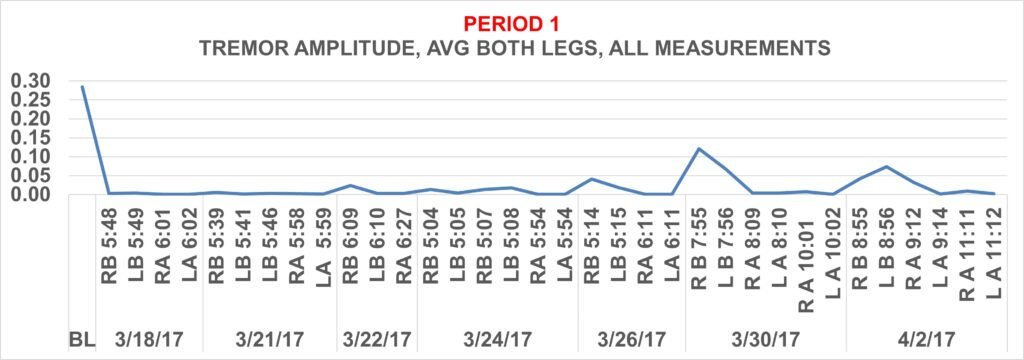
NOTE During period 1, measurements and TX sessions were conducted with Sam in a sitting position and his feet flat on the floor. Tremor was low as his muscles experienced limited stretching and tension. On 4/2/17, he lifted his heels off the floor and his tremor increased in both legs by over 29 times to [7.77 Left leg and 8.40 Right leg]. Raising his heels off the floor increased muscle tension further challenging stabilization.
The BEFORE measurements of 4/3/17 became the baseline for this new posture in PERIODS 2 and 3.
Despite posture limitations, there were substantial PERIOD 2 – 4/3/17 to 9/24/17 [174 days] and 7 TX sessions for an average gap between sessions of 28.9 days and an average improvement of 96.57% for both legs.
PERIOD 2 – 4/3/17 to 9/24/17 [174 days] and 7 TX sessions for an average gap between sessions of 28.9 days and an average improvement of 96.57% for both legs
PERIOD 3 – 9/24/17 to 5/13/18 [231 days] and 3 TX sessions for an average gap between sessions of 77days and an average improvement of 70.57% for both legs.
PERIOD 2 and PERIOD 3 are shown together but separate graphs are shown for Right vs Left leg results.
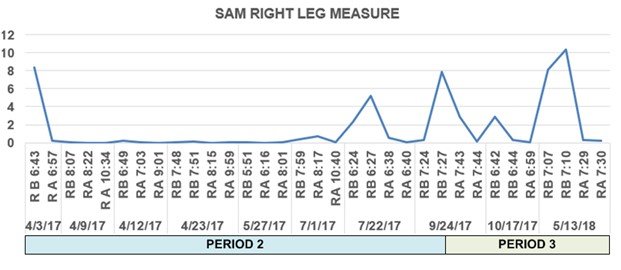
Sam Right leg peaks:
7/22
After a 22-day gap, tremor improvement decreased to 38%. One TX session and tremor was returned immediately to 93.22% and 2 minutes later to 99.71% improvement levels.
9/24
After a 2-month gap, tremor improvement decreased to 5,95%. One TX session and tremor was returned immediately to 65.71% and 17 minutes later to 98.04% improvement levels.
10/17/17
After a 3-week gap, tremor improvement decreased to 70% and returned to nearly 100% in 17 minutes following a TX session.
5/13
After a 7-month gap, tremor improvement decreased to -23% improvement to 96.92% in 19 minutes following a TX session.
In all 4 cases, after a substantial gap, tremor returns to levels proportional to the duration of the gap and with a single TX session, is restored to nearly 100% improvement.
Sam Left leg results
The Left leg shows a similar, albeit less severe, degradation of improvement wherein the same conclusions drawn for the Right leg apply.
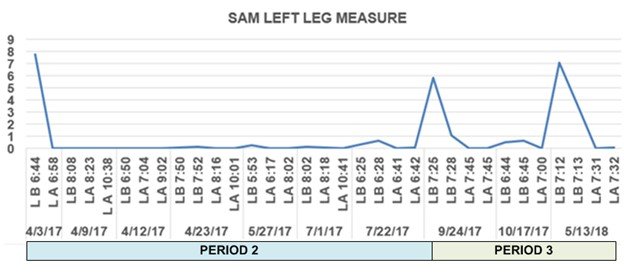
Sam realized:
1. Immediate 98% reduction in tremor of both legs the first time he used TX.
2. All [55] AFTER measurements covering all 3 Periods taken immediately or within hours following a TX session show an average TX session improvement for both legs of 99%.
3. Improvements in other PD symptoms including gait, rigidity, handwriting and energy level.
4. Insofar as mitigating other PD symptoms, Sam discontinued his participation with the TX project. Had he continued, his TX sessions would include performing motor tasks under challenging conditions like walking whilst carrying weights and practicing motor skills whilst stabilization is being perturbed
CARL IMPROVEMENT
We had a single TREMOREX session, the results of which are shown below. Carl’s trembling lips, rigidity, and balance improved. Immediately following the session, he left the room to climb a staircase and return without holding the handrail, something he could not do before TX.
TX sessions were not continued as Carl decided to follow the controlled program established by his neurologist.
First and only time
BEFORE 2.9
AFTER .33
Tx duration 12 Min
Improvement duration 18 Hours
Improvement 88.63%
WAYNE IMPROVEMENT
Wayne’s 1st session was a 5-minute impromptu session that resulted in an immediate reduction of 96.48%, albeit for a very short period of 5 to 10 minutes.
First time
BEFORE .1833
AFTER .0049
TX duration 5 Min
Improvement 96.48%
Improvement duration 5 – 10 Min
Long term – over a period of 6 weeks
Baseline 1.77
Avg AFTER baseline .1212
Improvement 93.15%
The graph and notes show post TX durations of much longer periods.
Wayne Tremor Amplitude
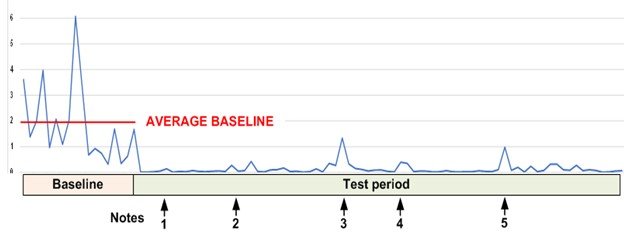
Baseline
Measurements were to be taken for several days to establish a tremor baseline prior to any TREMOREX sessions, but TX was inadvertently used during this period. However, TX had diminished effect on tremors because TX was set at the wrong RPM. Note the progressive decrease in tremor amplitudes during this period. Baseline measurements were averaged and used to establish a baseline that would have been higher had there been no TX sessions
TX rate change – RPM
During test period, small RPM changes were made, and duration of TX exercises reduced from 12 to 4 minutes. Spikes in tremor amplitude are generally a response to a cause as follows:
Notes
1. TX preceded by 1-day void
2. TX preceded by 2-day void
3. TX preceded by 4-day void and RPM change
4. Reduced exercise duration from 12 to 4 minutes
5. Unknown
Wayne had substantial improvement from baseline to test period. But Wayne reported tremor suppression duration was short, ½ hour or less. However, measurements show low tremor levels lasting throughout the test period as evidenced by the continued low levels of BEFORE and AFTER measurements.
Wayne reported his measurements were off because the weight of the phone reduced the tremor during measurements. This is because in addition to the amplitude, and more importantly, the force of the tremor was substantially reduced. When the force is reduced to zero, there is no tremor.
Many of Wayne’s sessions were short, 2, 4, or 5 minutes and often separated by days allowing partial return of tremor prior to the next session. Had Wayne continued with TX, increased session durations, and stayed on a schedule, [other subjects started with 15-minute sessions once per day and reduced them to 5 minutes when needed every several days or months], he would likely have realized continued long-term mitigation of tremors, an ability to stop tremor episodes mentally, and mitigation of other movement disorder symptoms.
DIANE IMPROVEMENT
Diane had essentially no tremor or it was suppressed by the medication she was on. She had other, perhaps all, PD symptoms. There are no quantitative results, but a video and comments expressed by Diane and others who witnessed the remarkable transformation are available on the website.
Improvement enormous, ubiquitous, systemic
You are invited to visit the website www.TREMOREX.com and contact me ggcimo@sbcglobal.net with commentary, questions and/or challenges.